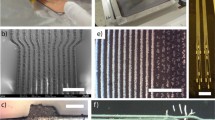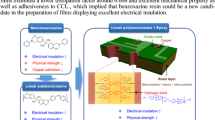Abstract
Multilayer elastic printed circuit boards (E-PCBs) have emerged as advanced configurations for integrating electronic components on elastomer substrates. However, weak inter-layer adhesion in elastic substrates can result in deformation-induced cracks and delamination in real-world applications. In this study, we present a novel approach to address this challenge by developing supramolecular sandwiched elastomers with high-adhesion skin and mechanically strong cores. This is achieved by precisely regulating the coordination bonds between different metal ions and the ethylenediamine groups within the aminated polydimethylsiloxane. The resulting sandwiched elastomer exhibits strong adhesion between layers (adhesion strength of 0.80 MPa), breaking strength of 0.81 MPa, Young’s modulus of 0.49 MPa, and maximum strain exceeding 500%. Leveraging these properties, the multilayered configuration of E-PCBs can be efficiently and securely assembled using the designed sandwiched elastomers through a simple layer-mounting method. This study offers a promising avenue for the simple and effective fabrication of mechanically stable multilayer flexible devices, eliminating the need for additional adhesive layers and complex structural constructions.

摘要
多层弹性印刷电路板被认为是在弹性基底上系统地集成各种电子元件的一种先进构造. 然而在实际应用中, 多层弹性基板之间的粘合界面很容易出现裂纹和分层, 这是层间粘附力较弱导致的. 在这里, 我们通过调节不同金属离子与侧链为乙二胺基团的聚二甲基硅氧烷之间的配位键, 得到了一种具有高粘附表皮和机械强韧内核的超分子复合夹层弹性体. 这种夹层弹性体可以实现层间的强粘附(粘附强度0.80 MPa), 同时兼具机械强度(断裂强度达0.81 MPa, 杨氏模量为0.48 MPa, 最大应变>500%). 通过分层组装策略, 此夹层弹性体可快速且牢固地组装具有多层结构的弹性电路板. 这项研究为简单高效地制备机械稳定的多层柔性器件提供了新的思路, 无需额外引入粘合层或者复杂的结构设计.
Similar content being viewed by others
References
Jiang Y, Ji S, Sun J, et al. A universal interface for plug-and-play assembly of stretchable devices. Nature, 2023, 614: 456–462
Lee W, Kim H, Kang I, et al. Universal assembly of liquid metal particles in polymers enables elastic printed circuit board. Science, 2022, 378: 637–641
Ma Z, Huang Q, Xu Q, et al. Permeable superelastic liquid-metal fiber mat enables biocompatible and monolithic stretchable electronics. Nat Mater, 2021, 20: 859–868
Lee KH, Ni X, Lee JY, et al. Mechano-acoustic sensing of physiological processes and body motions via a soft wireless device placed at the suprasternal notch. Nat Biomed Eng, 2020, 4: 148–158
Matsuhisa N, Chen X, Bao Z, et al. Materials and structural designs of stretchable conductors. Chem Soc Rev, 2019, 48: 2946–2966
Song H, Luo G, Ji Z, et al. Highly-integrated, miniaturized, stretchable electronic systems based on stacked multilayer network materials. Sci Adv, 2022, 8: eabm3785
Huang Z, Hao Y, Li Y, et al. Three-dimensional integrated stretchable electronics. Nat Electron, 2018, 1: 473–480
Luo Y, Wang M, Wan C, et al. Devising materials manufacturing toward lab-to-fab translation of flexible electronics. Adv Mater, 2020, 32: 2001903
Ji S, Chen X. Enhancing the interfacial binding strength between modular stretchable electronic components. Natl Sci Rev, 2023, 10: nwac172
Lucchini R, Cattarinuzzi E, Maraghechi S, et al. Delamination phenomena in aluminum/polyimide deformable interconnects: In-situ micro-tensile testing. Mater Des, 2016, 89: 121–128
Tang M, Jiang Z, Wang Z, et al. High-adhesion PDMS/Ag conductive composites for flexible hybrid integration. Chem Eng J, 2023, 451: 138730
Jiang Q, Zhang S, Jiang J, et al. Pneumatic enabled vertical interconnect access of liquid alloy circuits toward highly integrated stretchable electronics. Adv Mater Technologies, 2021, 6: 2000966
Chen X, Song Y, Su Z, et al. Flexible fiber-based hybrid nanogenerator for biomechanical energy harvesting and physiological monitoring. Nano Energy, 2017, 38: 43–50
Yi H, Lee SH, Ko H, et al. Ultra-adaptable and wearable photonic skin based on a shape-memory, responsive cellulose derivative. Adv Funct Mater, 2019, 29: 1902720
Qi D, Zhang K, Tian G, et al. Stretchable electronics based on PDMS substrates. Adv Mater, 2021, 33: 2003155
Paoletti P. Formation of metal complexes with ethylenediamine: A critical survey of equilibrium constants, enthalpy and entropy values. Pure Appl Chem, 1984, 56: 491–522
Israelachvili JN. Intermolecular and Surface Forces 3rd ed. Cambridge: Academic press, 2011.
Blaiszik BJ, Kramer SLB, Olugebefola SC, et al. Self-healing polymers and composites. Annu Rev Mater Res, 2010, 40: 179–211
Zhang Y, Ruan K, Gu J. Flexible sandwich-structured electromagnetic interference shielding nanocomposite films with excellent thermal conductivities. Small, 2021, 17: 2101951
Wu YH, Deng ZF, Peng ZF, et al. A novel strategy for preparing stretchable and reliable biphasic liquid metal. Adv Funct Mater, 2019, 29: 1903840
Xu Y, Rothe R, Voigt D, et al. Convergent synthesis of diversified reversible network leads to liquid metal-containing conductive hydrogel adhesives. Nat Commun, 2021, 12: 2407
Kang J, Son D, Wang GJN, et al. Tough and water-insensitive self-healing elastomer for robust electronic skin. Adv Mater, 2018, 30: 1706846
Wu Y, Huang L, Huang X, et al. A room-temperature liquid metalbased self-healing anode for lithium-ion batteries with an ultra-long cycle life. Energy Environ Sci, 2017, 10: 1854–1861
Chiechi R, Weiss E, Dickey M, et al. Eutectic gallium-indium (EGaIn): A moldable liquid metal for electrical characterization of self-assembled monolayers. Angew Chem Int Ed, 2008, 47: 142–144
Acknowledgements
This work was financially supported by the National Natural Science Foundation of China (22035008). We thank Yifan Wang and Xuanze Li from the EMPA characterization at the Institute of Process Engineering, Chinese Academy of Sciences, Beijing.
Author information
Authors and Affiliations
Contributions
Author contributions Wang Z and Wang S designed and engineered the samples; Teng P and Wang Z conceived the sandwiched structure; Teng P, Wang Z, Kang Y and Zhang Y performed the experiments; Teng P wrote the paper with support from Wang Z and Wang S. All authors contributed to the general discussion.
Corresponding author
Ethics declarations
Conflict of interest The authors declare that they have no conflict of interest.
Additional information
Peicheng Teng received his Bachelor’s degree from Northeast Normal University in 2017. Now he is a doctoral candidate at the Technical Institute of Physics and Chemistry (TIPC), Chinese Academy of Sciences. His research interest focuses on the design and fabrication of the interfacial connection of flexible electronic devices.
Zhao Wang received her PhD degree from the TIPC, Chinese Academy of Sciences at 2022. Now she is a post doctor at the TIPC. Her research interest focuses on the design and synthesis of smart adhesives and their practical applications.
Shutao Wang received his PhD degree from the Institute of Chemistry, Chinese Academy of Sciences in 2007. Now he is a full professor at the TIPC. His research interest focuses on the design of multi-scale adhesive interface.
Supplementary information Supporting data are available in the online version of the paper.
Supplementary Information
Rights and permissions
About this article
Cite this article
Teng, P., Wang, Z., Kang, Y. et al. Metal-ion-tunable adhesive elastomers for mounting the multilayer elastic circuit. Sci. China Mater. 66, 4054–4061 (2023). https://doi.org/10.1007/s40843-023-2577-x
Received:
Accepted:
Published:
Issue Date:
DOI: https://doi.org/10.1007/s40843-023-2577-x




